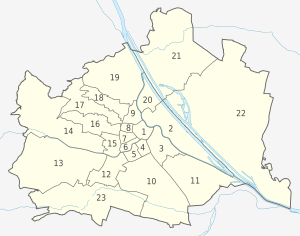Districts of Vienna
The districts of Vienna (German: Wiener Gemeindebezirke) are the 23 named city sections of Vienna, Austria, which are numbered for easy reference. They were created from 1850 onwards, when the city area was enlarged by the inclusion of surrounding communities. Although they fill a similar role, Vienna's municipal districts are not administrative districts (Bezirke) as defined by the constitution; Vienna is a statutory city and as such is a single administrative district in its entirety.
The seats of Bezirksvorsteher (political district head) and Bezirksvertretung (district assembly) are located in the respective districts, with the exception of the 14th district, whose political representatives reside in the 13th district (to which much of the 14th had belonged until 1938). The Magistratisches Bezirksamt (district office of the city administration, not headed by the political district head) in four locations combines services for two districts:
- for the 1st and 8th district in the 1st,
- for the 4th and 5th district in the 5th,
- for the 6th and 7th district in the 7th,
- for the 13th and 14th district in the 13th.
Hence Vienna has 19 district offices.
Since 2002, in Austria, instead of the police the mayors are responsible for objects found in public places. In Vienna, the mayor has ordered the district offices to perform the functions police stations have performed concerning found objects until then. Since 2005, by federal law the districts in all of Austria are responsible for issuing passports and registering residents, tasks until then covered in Vienna by the Federal Police. The mayor of Vienna again has ordered the district offices of the Magistrat to perform these functions.
Optimizing overhead costs has gone farther with the Federal Police in Vienna. The 23 District Police Commands in 2002 have been reduced to 14 City Police Commands. Reducing the number of small districts by mergers, as happened in Berlin after the 1990 reunification of Germany, has not even been discussed in Vienna, since the district assemblies function as breeding factories for the political parties' representatives.
District locations

The boundaries of each district have been shown as a layer on this map. The following are locations of the 23 districts:
- Innere Stadt is the city centre, with numerous historical sites and few residents.
- Leopoldstadt is the island between the Danube and the Danube Canal, with Praterstern, Vienna's most frequented traffic spot, and Giant Wheel.
- Landstraße is on the right bank of the Danube Canal, and includes the Belvedere.
- Wieden is a small district south of the city centre.
- Margareten was separated from Wieden in 1861.
- Mariahilf is a small district on the main shopping lane leading to Westbahnhof.
- Neubau is a small district on main shopping lane leading to Westbahnhof, and includes the Museumsquartier, a large cultural complex.
- Josefstadt is a small district close to the Rathaus, Parlement, and the University of Vienna.
- Alsergrund is the General Hospital district, and includes Sigmund Freud's residence.
- Favoriten is in the southern part of Vienna, and has the largest population, the new main train station, and the city's thermal spa.
- Simmering is on the right bank of the Donaukanal, and includes the Zentralfriedhof which is the main cemetery.
- Meidling is on the southern bank of the Wien river.
- Hietzing is on the southern bank of the Wien river, and includes Schönbrunn Palace.
- Penzing is on the northern bank of the Wien river, and was separated from Hietzing in 1938. It includes Otto Wagner's Church Am Steinhof.
- Rudolfsheim-Fünfhaus is on the northern bank of the Wien river.
- Ottakring is on the western outskirts and includes Vienna's traditional brewery.
- Hernals is on the northwestern outskirts of Vienna.
- Währing is on the northwestern outskirts of Vienna, and includes the Türkenschanzpark around which was founded the University of Natural Resources and Life Sciences, Vienna.
- Döbling is on the northern outskirts of Vienna, and includes the classical Heurigen district.
- Brigittenau is on the same island as Leopoldstadt, and was separated in 1900.
- Floridsdorf is on the left bank of the Danube, and includes industry areas. It is the northernmost part of Vienna.
- Donaustadt is on the left bank of the Danube, and is the largest district in size. It includes UN City, the largest convention hall in Vienna.
- Liesing is the southernmost least population dense district, and includes the Wotruba Church.
By looking at the postal code it can be determined in which district a given address is located: 1XXA - 1 denotes Vienna, XX the district number (if it is a single digit then with a leading zero), A is the number of the post office (irrelevant in this case, usually zero). Example: 1070 for Neubau. Exceptions of that are 1300 for the Vienna International Airport located in Lower Austria near Schwechat, 1400 for the UN Complex, 1450 for the Austria Center Vienna, and 1500 for the Austrian UN-Forces.
The numbering of the districts reflects to some degree when they were incorporated into Vienna.
- The first district comprises not much more than Vienna's historic centre, which used to be the entire city until 1850.
- Districts 2–9 (and 20 which was in 1900 separated from the second district), incorporated in 1850, are known as Innenbezirke (inner districts) and composed of the former Vorstädte, which were located inside the Linienwall, the second ring of fortifications around Vienna. Those districts are located within the Gürtel today.
- The other districts, incorporated between 1874 and 1938, mainly in 1892, are known as Außenbezirke (outer districts) and are the former Vororte.
District populations
The following are current district populations, as of 2016-01-01 (source[1]):
|
|
See also
For their creation and administration, see the Districts and Enlargement chapter of the Vienna article.
References
External links
Districts of Vienna Interactive Map
![]() Media related to Districts of Vienna at Wikimedia Commons
Media related to Districts of Vienna at Wikimedia Commons
